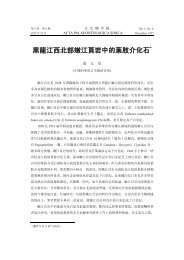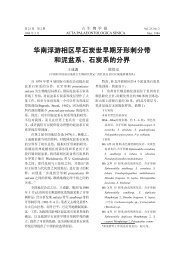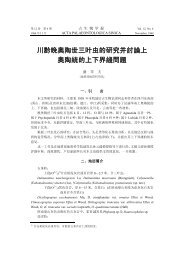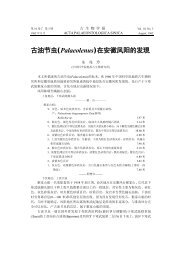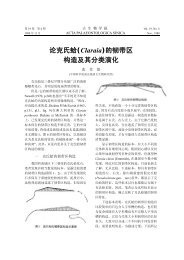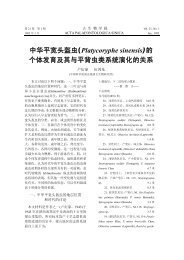ephedroids from the Early Cretaceous Yixian Formation in Liaoning ...
ephedroids from the Early Cretaceous Yixian Formation in Liaoning ...
ephedroids from the Early Cretaceous Yixian Formation in Liaoning ...
Create successful ePaper yourself
Turn your PDF publications into a flip-book with our unique Google optimized e-Paper software.
246 C. Ryd<strong>in</strong> et al.: <strong>Cretaceous</strong> <strong>ephedroids</strong> <strong>from</strong> Ch<strong>in</strong>a<br />
rounded, elliptic, 2.5–3.5 mm long, 1.2–2 mm<br />
wide.<br />
Etymology. From <strong>the</strong> robust morphology<br />
of <strong>the</strong> plant.<br />
Holotype. PB20719. (Figs. 16, 18).<br />
Paratype. (Counterpart) PB20720. (Fig. 17).<br />
Locality. Huangbanjigou Section, Beipiao,<br />
Liaon<strong>in</strong>g, Ch<strong>in</strong>a.<br />
Stratigraphic position and age. Jianshangou<br />
Bed, <strong>Yixian</strong> <strong>Formation</strong>, <strong>Early</strong> <strong>Cretaceous</strong><br />
(Barremian-early Aptian?).<br />
Description and comments. The type material<br />
of Liaoxia robusta comprises two compression<br />
fossils of an ephedroid, female plant,<br />
part and counterpart, with oxidized organic<br />
material preserved. The shoot is 17 cm long<br />
(Fig. 16), but on <strong>the</strong> counterpart, only <strong>the</strong><br />
uppermost 8 cm are preserved (Fig. 17). No<br />
<strong>in</strong>ternal or external anatomical details are<br />
preserved. Precipitations surround <strong>the</strong> plant<br />
rema<strong>in</strong>s and make stems and leaves appear<br />
wider than <strong>the</strong>y are.<br />
Stems are erect with nodes and <strong>in</strong>ternodes,<br />
1.5–2 mm thick, thicker at nodes, and have<br />
longitud<strong>in</strong>al striations-ridges. Phyllotaxis is<br />
opposite and decussate with multiple axillary<br />
units. Leaves are l<strong>in</strong>ear, 15–20 mm long and<br />
appear 1.5–2 mm wide, but <strong>the</strong> width also<br />
comprises precipitates and <strong>the</strong> leaves were<br />
probably only 0.5–1 mm wide. Indist<strong>in</strong>ct<br />
rema<strong>in</strong>s of three or four ve<strong>in</strong>s are present on<br />
some leaves. The plant has about 15 ovulate<br />
cones that are rounded to ellipsoid <strong>in</strong> longitud<strong>in</strong>al<br />
outl<strong>in</strong>e. Cones vary <strong>in</strong> length between 7<br />
and 16 mm, but are all about 6–8 mm wide,<br />
sessile or pedunculate, and are positioned<br />
axillary at nodes or term<strong>in</strong>ally on branches.<br />
Cones comprise between approximately 4 and<br />
10 pairs of reflexed and decussately arranged<br />
bracts. The bracts are ovate, 4–7 mm long,<br />
with a long and acute to attenuate apex. Seeds<br />
are rounded to elliptic, 2.5–3.5 mm long and<br />
1.2–2 mm wide, but no cell structures or o<strong>the</strong>r<br />
anatomical details are preserved. There is one<br />
seed <strong>in</strong> <strong>the</strong> axil of all cone bracts, <strong>in</strong>clud<strong>in</strong>g<br />
proximal bracts.<br />
This plant differs <strong>from</strong> o<strong>the</strong>r species of<br />
Liaoxia <strong>in</strong> that all features are larger. Fur<strong>the</strong>r,<br />
it has multiple axillary branch<strong>in</strong>g, which has<br />
o<strong>the</strong>rwise only been observed for Liaoxia<br />
elongata and L. longibractea, and <strong>the</strong>se species<br />
are clearly different <strong>from</strong> L. robusta <strong>in</strong> <strong>the</strong><br />
characters of <strong>the</strong> cones. Liaoxia robusta differs<br />
<strong>from</strong> Ephedra <strong>in</strong> <strong>the</strong> presence of seeds <strong>in</strong> <strong>the</strong><br />
axil of all bracts, not only <strong>in</strong> distal pairs as <strong>in</strong><br />
extant Ephedra.<br />
A detached w<strong>in</strong>ged seed occurs <strong>in</strong> close<br />
association with Liaoxia robusta (Fig. 18).<br />
The seed body of this isolated seed is of<br />
approximately <strong>the</strong> same length as <strong>the</strong> <strong>in</strong> situ<br />
seeds and <strong>the</strong> possibility that it orig<strong>in</strong>ates<br />
<strong>from</strong> a Liaoxia cone cannot be ruled out, but<br />
<strong>the</strong> shape of <strong>the</strong> seed and <strong>the</strong> nature of <strong>the</strong><br />
w<strong>in</strong>g suggest that it was more likely produced<br />
by one of <strong>the</strong> conifers reported for <strong>the</strong> <strong>Yixian</strong><br />
<strong>Formation</strong>.<br />
Liaoxia longibractea Ryd<strong>in</strong>, S.Q. Wu et Friis<br />
sp. nov.<br />
Specific diagnosis. As for <strong>the</strong> genus with <strong>the</strong><br />
follow<strong>in</strong>g dist<strong>in</strong>ctions. Branches c. 1.5 mm<br />
wide, with multiple axillary branch<strong>in</strong>g. Cones<br />
sessile to very shortly pedunculate, rounded,<br />
3.5–4 mm long ()15 mm <strong>in</strong>clud<strong>in</strong>g bract<br />
apex), c. 2–3 mm wide, with 1–2 pairs of<br />
bracts. Cone bracts reflexed, 10–15 mm long,<br />
extended with a setose apex, two parallel<br />
ve<strong>in</strong>s. Seeds elliptic, 2.5–4.0 mm long, c.<br />
1 mm wide.<br />
Etymology. Named after <strong>the</strong> very long and<br />
narrowly extended cone bracts.<br />
Holotype. PB20725 (Fig. 19).<br />
Paratype. PB20726 (<strong>the</strong> counterpart,<br />
Fig. 20).<br />
Locality. Fanzhangzi Section, L<strong>in</strong>gyuan,<br />
Liaon<strong>in</strong>g, Ch<strong>in</strong>a.<br />
Stratigraphic position and age. Dawangzhangzi<br />
Bed, <strong>Yixian</strong> <strong>Formation</strong>, <strong>Early</strong><br />
<strong>Cretaceous</strong> (Barremian-early Aptian?).<br />
Description and comments. The type material<br />
of Liaoxia longibractea comprises two<br />
relatively well-preserved compression fossils<br />
(part and counterpart) with small amounts of<br />
oxidized organic material preserved. No <strong>in</strong>ternal<br />
or external anatomical details are pre-




